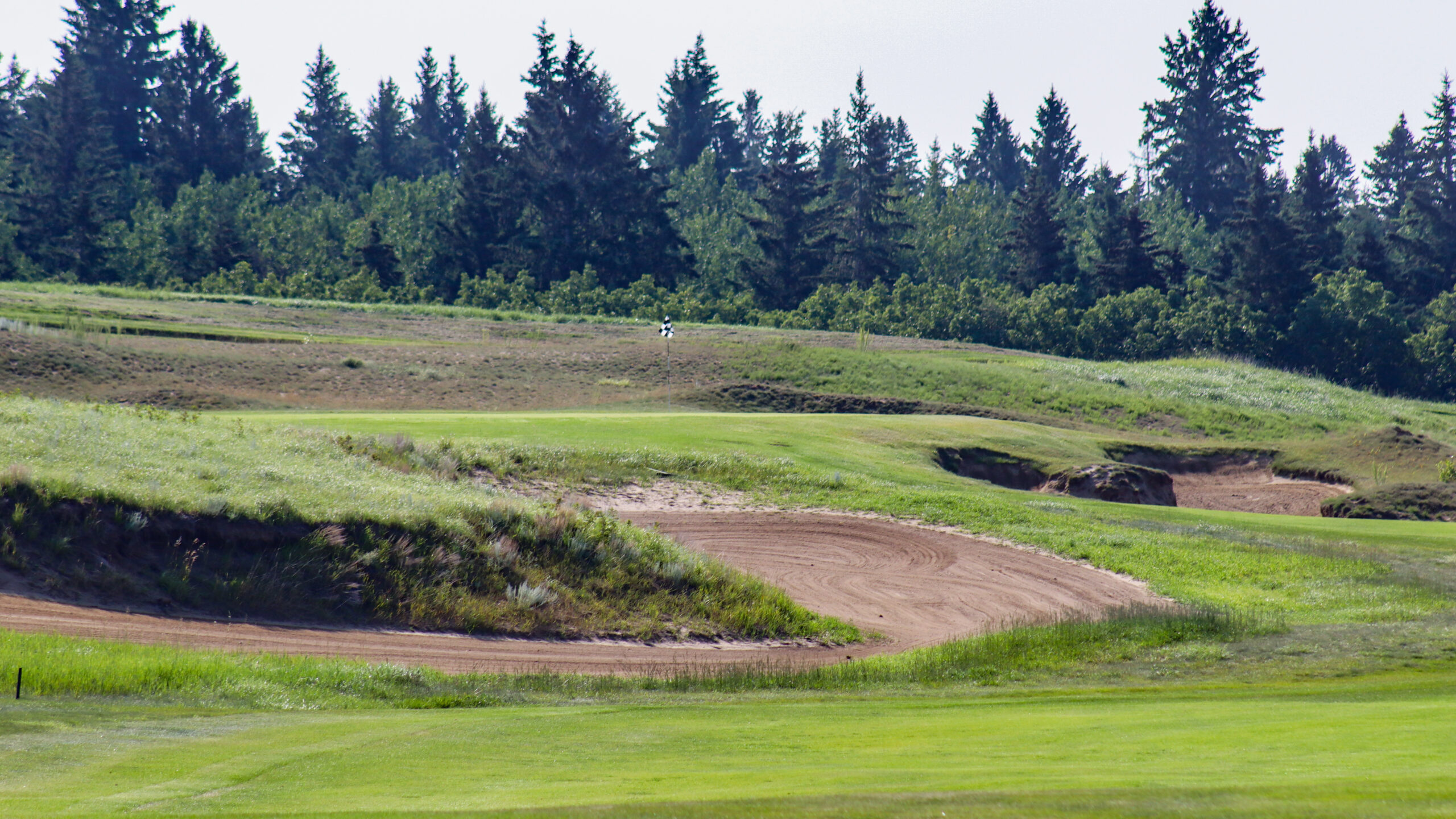These days, my list of Canadian courses to play is dwindling. I just completed the 2022 SCOREGolf Canadian Top 100, I have three left on Beyond The Contour‘s, and five on Top 100 Golf Courses. Plus, a list of courses I’d like to see eventually, both notable and hidden gems, ranging from Vancouver Island to the Yukon, southern Nova Scotia to the mining towns of northern Ontario and Quebec.
A quick rewind: before I even knew what a Top 100 was or if I should care about it (I care a bit, but they all have flaws, including ours), Wolf Creek was one of the first notable golf courses I ever heard about or played. Alongside Banff Springs, which the MJT Junior Tour visited every May, Wolf Creek’s two course facility hosted a slew of events.
- The 11th at Wolf Creek’s Links course
- Wolf Creek Old’s 5th, left, and 9th, right
My first time to the facility came in 2014, where I played Wolf Creek’s Old course. Built in 1987, Rod Whitman’s first solo project has very obvious inspirations from his time working under Pete Dye, which was ongoing while building this course in the town he grew up and for Ryan Vold, his high school friend. A year later, I visited the Links, a combination of a front nine built in 1992 with features similar to the Old, though not quite as exciting, and a back nine built thirty years later, much more inline with Sagebrush, Blackhawk, and Cabot Links.
I never really liked the Old, but perhaps that’s because I found it so difficult. I distinctively remember shooting 78 and losing by 4 in 2014 (!!), while finishing 2nd comfortably. It was an absolute battle to play: you were either in the trees fighting lost balls on either side, or out in the open, exposed to the prairie winds (where it usually absolutely howled). Links is difficult as well—in truth, all Rod Whitman golf courses are hard in my opinion—but the back nine, exposed through the sandy scrapes of the rolling terrain of central Alberta, with elements of both Blackhawk and Bandon Trails, Sagebrush and Friar’s Head, made it an instant favourite and preferred to the Old. It had a bit of give, but still remained tough. If you hit it well, you could make birdies, but a mistake or two and things could get out of hand quick. The front nine, built in 1992 thirty years prior to the aforementioned back nine, is and always will be the weakest nine on the property (until a renovation happens, if that ever happens). Regardless, the back was enough to elevate its status, which I still stand by as having the best consecutive nine holes in western Canada and perhaps the entire country.

Fast-forward almost a decade: I now live in Toronto, a flight and a car ride away from Wolf Creek. I have family in Red Deer, but anytime I get the chance to either go home or visit them, Wolf Creek is closed for the season. In the first golf season with COVID-19, I went back home to Lethbridge, Alberta as schools moved to online learning. Golf season began, and Wolf Creek was one of the first to open. The Links opens earlier, so I played opening day, 2019 after a hiatus from the property. Not playing the Old as well left a sour taste in my mouth, but I couldn’t control that.
Luckily, I returned in 2023 to play both courses, though a bit different from playing 2014. A recent ownership change as a result of receivership last fall has the course playing soft and spongy, with more thatch than usual and some of the Whitman shaping softening with age and mismanagement. As evident by the comments on SCOREGolf’s Top 59 public release, the public perception of Wolf Creek has fallen to a state of crisis, but truthfully as an Albertan, it was never that well recieved. Blame it on education: most golfers are unable to truly see the brilliance, which is a shame. In my circles growing up, Sundre was a golf course better thought of than Wolf Creek—the “Augusta of Alberta”—and a testament to the poison seeping through the television screens each April. Wolf Creek, where the ball bounced off the cripsy firm brown turf, was somehow always seen in a negative light to the Splash Mountain that is other courses irrigation schedule. You could never land a ball on the greens at Wolf Creek with anything more than pitching wedge, and so it suffered. A shame as that was the way it was designed and intended to play!

Back to my recent visit, which showcased a golf course in need of help, but two brilliant layouts nonetheless. Sure, they don’t present nearly as they should. A tough winter combined the old ownership group tossing in the towel before winter prep happened likely did not set the golf course up for success in the new year. For me, though, this was a litmus test visit: since 2014, I have played nearly 400 golf courses and most of the Canadian Top 100. I remembered Wolf Creek, but did I really remember Wolf Creek?
What I left with was an interesting conflicy to debate amongst myself and friends: Old, or Links? I remember comfortably favouring the Links, mainly off the strength of the new nine alone, and finding the Old a bit tired, with too many trees and less memorable moments. With a recent, fresh outtake in my mind, It felt like my eyes were opened yet again, as if I had seen the property for the first time yet again. The Old’s routing, dipping in and out of the trees, is magnificent and flows exceptionally well. The first three, blending the trees with expansive prairies, sets the tone with the biomes, before the 4th—nicknamed “Hawk’s Alley” and the originally planned 18th hole—submerges the golfer into the trees in a very Pete Dye-esque hole. The golfer emerges out of the trees on the 5th, and the cycle continues until the end, where the golfer dips into the trees one final time on the 16th, only to emerge again on the 17th green.

Throughout the round, you float throughout the landscape, balancing the trees (tee shot on 2, 4th hole, approach on 9, last half of 11, 12th & 13th hole, 16th hole) and the sandy expanse of Central Alberta. This creates a compression and release unlike almost any golf course in Canada. There are comfortable shots to be found where the golfer can swing with ease, like the layup on the 6th or the tee shot on the short 7th, which juxtapositions with some of the most nerve wracking shots around at the 4th or 12th. All this compounds with a set of green complexes that compete with Pete Dye’s best: better than Kiawah, better than Sawgrass, and so forth. The interior movement on the 1st, for example, with its two nipples as the green falls away from the line of play, is exceptional and worthy of study, as is the 11th, with its hump pushing balls away from the middle. Everything on the Old serves a purpose. No single slope, hump, bump, or hollow goes without a reason, and at some point over the course of a thirty-six hole stint, you most likely realize each purpose.

Thankfully, all the good memories of the Links came back in a recent visit. I get the sour feeling on the front nine—always have, in fact. In truth, it is hard, penal golf for most of the round. Strategically, the angles make sense: on the 3rd, for example, playing closer to the water, left, makes the most sense to open up the green, while playing to the inside corner of 7 lets the golfer come directly up the mouth of the green. Yet, the angles are so severe, with not enough width to really utilize them, that it starts to feel too intense. On paper, they present strategically and conceptually they pass, but in reality, they often come off as too penal to be utilized the way they were designed. As a result, the front is a bit of a slog, although there are a couple moments worth mentioning.
The greens on the for the front nine’s one shot holes, in particular, are rather engaging. Specific mention to the 6th, an absolute brute of a hole at 235 or so from the back deck, with a severely raised surface falling off hard on the right to a collection area. The second, with its small surface featuring rolling waves like the Atlantic during hurricane season, is so severe, yet wildly entertaining to hit shots into, around, and on.

The par 4’s—six of them in total—are generally weak here, with little to write home about… other than the 7th, which doglegs right and up the slope. Most of the front nine could likely have 15-20% more width that would accentuate the concepts, but in a vacuum, I don’t mind a bit of tightness. In moderation throughout the round, it works out nicely: that is, after all, what makes the Old’s pacing so lovely to experience as it weaves in and out of tight and open. Sometimes, it makes you hit it through a bowling alley, while other times, it lets you work it around what is essentially a farmers field. This is true at the Links as well, but it comes in a sharp juxtaposition crossing Highway 604 between the two nines. I prefer the Old, where every couple holes, it switches gears. The Old feels like an experienced driver handling a clutch of a new sports car, while the Links feels like a sixteen-year-old learning to drive on the 1980s family car beaten to a pulp with the deepest clutch you’ve ever seen (whiplash, anyone?).
Like learning a manual transmission for the first time, once it gets going, it is just like driving a normal car. The moment of relief comes on the 9th, a big, brawny par 5 where the first true option is presented on the layup, navigating a sea of bunkering in the fairway. After walking under the highway, the 10th introduces you to the expansive, option-filled back nine, where the quasi-Cape tee shot tempts you into going for the green. I remember being able to potentially drive this green with how firm and fast it was, coupled with the predominant wind coming from behind. These days, the golf course is soft enough where it is a full wedge in.

The 10th on the Links introduces the golfer to the most expansive holes on the entire two-course property
The aforementioned 11th (above) and 15th, sharing “Hell’s Full Acre” (yes, a full acre of sand), compliment each other brilliantly, with the former tumbling down the landscape blindly, with the latter rising up around the sand bleeding into the fairway a la Pinehurst No. 2. These two par 5’s, working across the same plot of land in opposite directions, showcase Whitman’s strengths as an architect: the 11th, downhill, and 15th, uphill, ask engaging questions on both, yet completely different tactical approaches are required. The 11th, against the base of a big blowout bunker, asks the golfer to get it in play over the blind tee shot with an open front to the green allowing those who succeed to get home in two or three. The 15th, with its visually open tee shot, pinches golfers the closer they get to the green.
In between the two three-shot holes, a clinic in shot-making courtesy of the two four-shot holes, with the split 12th forcing golfers to avoid the centreline bunkers. The 13th, in my estimation the best hole not only on the Links, but the entire golf course, mistakenly comforts the golfer into an easy tee shot, but in truth is anything but. A wide, gentle tee shot is quickly realized as one that the golfer must challenge the left bunker to have the easiest approach in. Flair it out right and be safe yes, but for those looking to gain an advantage, up the left is the play.
- Nicknamed “Kansas” for Dave Axland’s role in the 13th, it is said this hole draws similarities to the famed Prairie Dunes in Hutchinson, KS
- The 13th from the ground, where bailing out right brings the very deep bunker into play even more
After the expansive loop of 11-15, the golfer dips into the trees for the first time since the front nine on the 16th with a very Bandon Trails-infused vibe, followed by a short, funky par 3 up the hill, and a par 4 finishing hole that is similar to its older siblings finishing hole.
The difference in preference is what really caught my eye after re-introducing myself to the facility. Without a doubt, conditioning and presentation are not where they once were, let alone where they need to be for such great golf courses. To anyone who knows anything, however, they are excellent layouts and golf courses waiting to be fully realized. Even more than that, the juxtaposition in style and feel between two golf courses in a single property, from a single architect nonetheless, is a massive asset from a resort perspective. If makes it worth seeing as a single entity, and a driving factor in why it can comfortably sit among the best 36 hole facilities in the country.

This created a dilemma in my mind, and one that dives into one’s psyche: can you overlook flaws? If you prefer the Links, I reckon you tend to lean towards albums with a lot of hit records, rather than an overall body of work (song vs album discussion and what matters is still a discussion point in music). You can overlook some minor plot holes, like in “TENET,” and you prefer action and adventure over the slow builds that can sometimes take a while to come to fruition. Finally, you are not one for the Michelin Guide’s nonsense of a ten-course, small plate tasting meal… you’d rather go to the trendy cool bar that has a better vibe and music playing. Those large plates at a gastropub are much more your vibe, and for good reason.
On the flip side, if you like the Old, you value the entire body of work rather than the singles that stick around on the radio. You maybe even prefer a novel to a movie, but if you are watching something on the big screen, it might be something like “Once Upon a Time in Hollywood” or “Uncut Gems,” which takes awhile to unravel. You potentially even prefer the new “The Batman” to Christopher Nolan’s “The Dark Knight,” largely because you feel like having that background of Batman being ‘the world’s greatest detective’ and the slow burn of finding out what The Riddler is up to makes for a better, more fulfilling watch. Furthermore, you don’t mind the ten-course tasting menus, the chef is trying to tell a story, and you’re here to listen to that symphony of flavours.

The point is, the Links has, without a doubt, the higher high’s: the entire back nine, for one, but the par 5, 11th, par 4, 14th, and the par 3, 6th are ‘best in class’ class contenders. If you prefer that, you are able to overlook the weak moments that come at the 1st, 4th, 5th, and maybe even the 8th. If you prefer the Old, you are okay that no par 4 is as good as the 13th on the Links, for example, but you value that the Old continues to stylistically and conceptually tell a single story in a way the Links does and cannot. To me, there is no right or wrong answer—they both are fantastic—but it asks an interesting question, and one that perhaps means more than just preference in golf course. Golf that relates to real-world discussion and debate is even more fascinating than judging golf in a vacuum, and to me, it is part of the reason why these two golf courses are special. When preference in golf course comes down to one’s psyche and what their overall preference is on culture, music, movies, food, travel, etc, it starts to make you think about the bigger picture. To me, Wolf Creek did just that.













After playing it 1-2 a year for the past 25 years, I became a member at Wolf Creek. I used to think it was always overrated, but after playing 30 rounds combined on both the Old & Links courses this spring, I have fallen in love with both. With the new ownership of Golf North, there has been extensive renovations ongoing to the Proshop&Clubhouse. As well the courses are seeing a revival of the greens and cart paths. I’m excited to play a full year here in 2024.